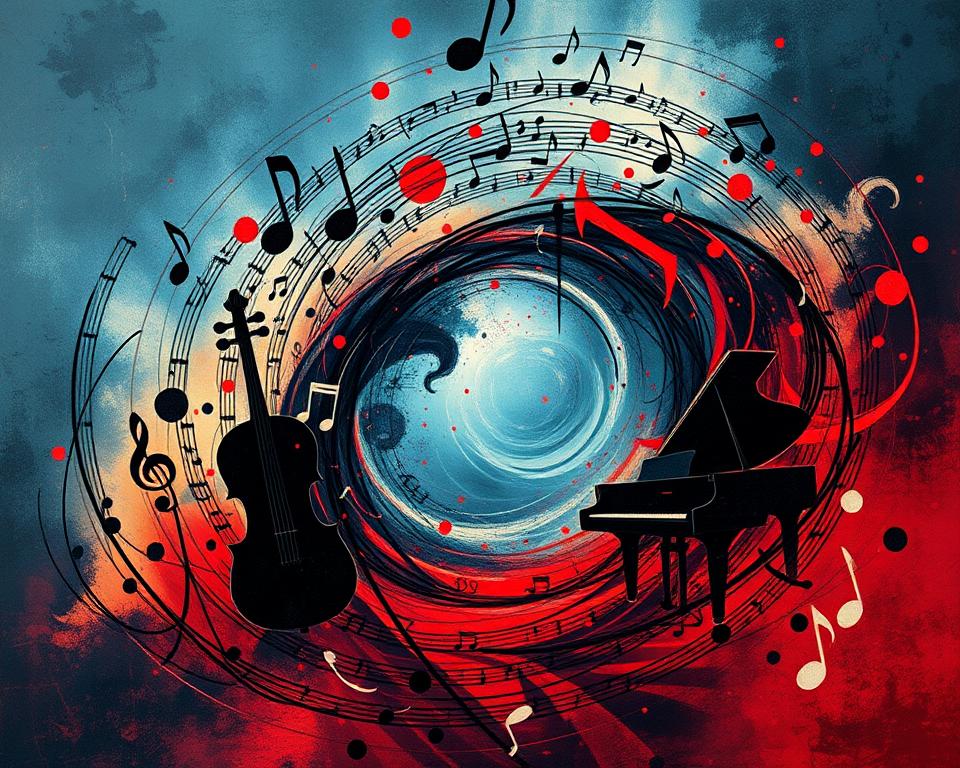Did you know that emotion in music was first deeply explored by Meyer in 1956? His work, “Emotion and Meaning in Music,” started us on the path to understanding music and emotions. This is key in music critique, where we look at how music makes us feel.
Music is a strong way to share and feel emotions. Listeners connect with music in different ways. The latest studies show that feeling music’s emotions is complex. It involves many aspects, like how we react and what we intend to feel.
We’ll look at how music critique analyzes a piece’s emotional impact. We’ll consider melody, harmony, and rhythm. This helps us understand music’s emotional power better. It’s important for both music lovers and critics to evaluate music’s emotional impact.
The Importance of Emotional Critique in Music
Emotional critique in music is key. It refines songs through feedback and review. This ensures the emotions in the music are felt by listeners. Critics look at lyrics and music structure to grasp the emotional impact.
They offer a detailed appraisal of a song. This highlights what works well and what needs improvement.
Music deeply affects emotions and thinking skills. Learning to play an instrument boosts cognitive abilities and school grades. Musicians do better in verbal memory and spatial skills than non-musicians.
Emotional critique helps critics understand music’s impact on listeners. This feedback helps artists improve their work. It makes music that touches listeners on a deeper level.
Understanding Emotion in Lyrics
Lyrics are vital in emotional critique. They show the artist‘s feelings and goals. By studying lyrics, critics offer a detailed review of a song’s emotional themes.
Musical Composition and Emotional Impact
Musical composition is also crucial. It can stir emotions and set a mood. Critics examine the song’s structure to see how it affects emotions. They provide a full appraisal of the music.
Historical Context of Emotion in Music Critique
Emotion has always been key in music, with different genres stirring different feelings. Looking back, how we judge music’s emotions has changed a lot. Studies have shown how music affects us emotionally.
Classical music, like Beethoven and Mozart, has shaped how we critique music today. Their music reflects their lives and feelings. This has led to new ways to analyze music’s emotional impact.
In the last twenty years, studying emotions in the humanities has grown. This includes understanding music’s role in our emotions. Research has shown how art, including music, shapes our emotional lives.
Classical Influences on Modern Critique
Musicologists like Caterina Albano have explored music’s emotional power. They’ve looked at how music and memory connect. This has helped us understand music’s emotional impact better.
Evolution of Emotional Expression in Music
Music’s emotional expression has grown over time. Different styles have emerged, each with its own emotional depth. Studies on Beethoven’s *Leonore Overture no. 3* have shown music’s emotional reach. This has led to new ways to critique music’s emotional side.
Key Elements of Musical Emotion
Understanding music’s emotional impact involves several key elements. Analyzing and evaluating these elements is crucial for giving feedback on music. Research shows that kids start to feel music’s emotion early and get better at it as they grow.
Music’s structure, like tempo, mode, and loudness, affects how we feel. For example, fast music can make us excited or angry. Slow music often brings out sadness or calmness. Melody and harmony also play big roles in how we feel, with certain sounds making us happy or relaxed, and others exciting or angry.
Melody and Its Emotional Resonance
A smooth rhythm makes us happy, while an irregular one might make us laugh or feel uneasy. It’s very important to think about these elements when we give feedback on music. This helps us understand the music’s emotional impact better.
Harmony’s Role in Conveying Feelings
Harmony is also key in music’s emotional feel. Major or minor tonality can change how we feel, with major sounds happy and minor sounds sad. This shows how important harmony is in music’s emotional impact.
Rhythm and Emotional Pulse
The emotion we feel from music comes from many factors. These include the music’s structure, how it’s performed, who listens, the context, and more. By looking at all these elements, we can understand music’s emotional impact better. This helps us give more effective feedback.
Influential Critics: Past and Present
The world of music critique has been shaped by many voices, both past and present. These critics have helped us grasp the emotional power of music. Their critique and feedback have shaped how we see artists and genres.
Robert Christgau is a well-known music critic who has made a big impact. His review style is admired by many. Today, new critics are also influencing how we see music and its emotional depth.
The Legacy of Robert Christgau
Christgau’s work shows the power of music critique. His review style has influenced many. His feedback has helped launch the careers of many artists.
Contemporary Voices in Music Critique
Today, new critics are making a big difference. They help us understand music’s emotional impact. Their review and feedback are key to grasping music’s emotional depth.

In conclusion, critics play a huge role in how we see and analyze music emotionally. Their critique, feedback, and review have shaped our understanding of music’s emotional impact.
Genres Defined by Emotion
Music genres are often defined by the emotions they evoke. This makes emotional analysis key in music critique. Each genre has its own emotional traits.
For example, blues music is known for its soulful and melancholic sound. It’s often used to express sadness and longing.
Pop music, on the other hand, features heartfelt ballads that show love and vulnerability. The appraisal of these genres goes beyond their technical aspects. It’s about the emotional connection they make with listeners.
Punk rock, with its raw energy and rebellious spirit, expresses anger and frustration. A deep assessment shows that genres are more than just music. They’re about the emotional experiences they offer.
The melodies, harmonies, and rhythms in music can stir powerful emotions. This makes music a universal language that can cross cultural and linguistic barriers.
Understanding the emotional sides of different genres helps music critics give more detailed evaluation. This can help listeners appreciate their favorite music more. It also helps them find new genres and artists that touch their hearts.
Analyzing Emotion Through Performance
The emotional impact of music can change based on where it’s played. Live music and studio recordings have different settings that affect how we feel. Knowing these differences helps critics give better feedback.
Music critics can tailor their feedback by looking at the emotional impact of live and studio performances. They consider the audience’s energy, the setting’s intimacy, and the sound quality. This way, they understand how the music moves the audience and help artists improve.
The importance of stage presence should not be overlooked. An artist’s connection with the audience, through eye contact and movement, adds to the emotional impact. Critics can offer detailed feedback by considering these aspects.
Live Music vs. Studio Recordings
Live music offers a unique emotional experience due to the audience’s energy and the performance’s spontaneity. Studio recordings, however, allow for precision and a polished sound. Critics can provide deeper insights by considering these differences.
Tools and Techniques for Effective Critique
Creating a solid approach to music critique is key for giving helpful feedback. It helps artists improve their work. Looking closely at the music’s composition, melody, and harmony shows its emotional depth. This way, critics can understand the song’s emotional impact better and offer better reviews.
Building a personal critique framework is important. It helps analyze the emotional impact of a song. This framework guides in giving feedback that artists can use to grow. Focusing on the music’s emotional depth makes reviews more detailed and helpful for both artists and listeners.
The main aim of music critique is to offer thoughtful examination of the music. It highlights what’s good and what needs work. Using music theory and a personal framework, critics can give reviews that help artists improve.
Future Trends in Music Critique
As music changes, so does the way we critique and analyze it. New tech has changed how we hear and feel music. This change will only grow.
Technology’s Influence on Emotional Perception
New audio tech, like 3D audio and spatial sound production, is changing how we feel music. Places like the Sphere in Las Vegas use this tech to make live shows more real. It makes us feel closer to the music.
The Role of Diversity in Music Critique
It’s also key to have diverse perspectives in musiccritique. With more global music, we need to understand different cultures. This helps us see the true power of music from all around the world.
The music world is always changing, and so is the need for good critique and analysis. By using new tech and hearing from many voices, music will become even more meaningful to us all.










